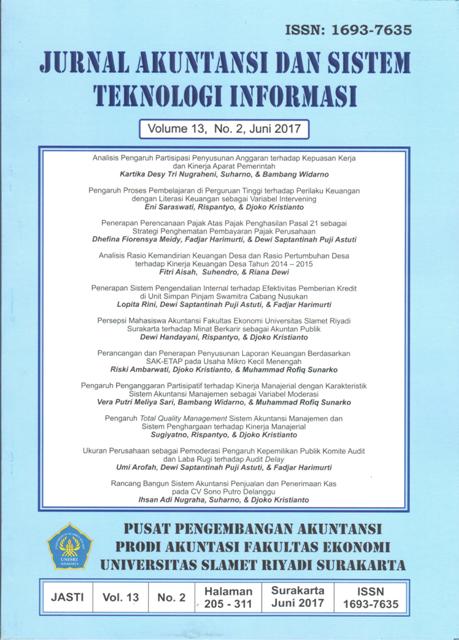ANALISIS RASIO KEMANDIRIAN KEUANGAN DESA DAN RASIO PERTUMBUHAN DESA TERHADAP KINERJA KEUANGAN DESA TAHUN 2014 – 2015 (Studi Kasus di desa Kecamatan Sumberlawang dan Kecamatan Miri)
Abstract
The purpose of this research was to analyze the financial performance of the
village in the village and Sub district Sumberlawang and Subdistrict Miri, Sragen
district 2014 – 2015. This research is descriptive research using this type of
qualitative approach. Data collected with the documentation. Data analysis using
ratio analysis financial independence the village and village growth ratio. The
results showed the financial performance of the village in the village in district and
sub district Sumberlawang Miri by 2014 to 2015 indicate the level of financial
independence the village was still low with an average level of financial
independence village in sub district of Sumberlawang of 12.5% by 2014 and 2015
10,3% and 19,9% of Miri subdistrict 2014 and 9,9% in 2015, the growth rate of the
village in the sub district of Sumberlawang for the original village of income and
total revenue has decreased growth, shopping routine and development spending has
increased growth and the growth rate of the village in district of Miri for total
revenues, shopping routine and development spending has increased fluctuating
growth. This indicates that financial performance is still low and not optimal so that
needs to be improved again its main sectors of the original village of income.
Keywords: financial self-sufficiency ratio ratio of the growth of the village, the
village, the village's financial performance
Downloads
Published
Issue
Section
License
Authors who publish this journal agree to the following terms:
- Authors retain copyright and grant the journal right of first publication with the work simultaneously licensed under a Creative Commons Attribution License that allows others to share the work with an acknowledgement of the work's authorship and initial publication in this journal.
- Authors can separately make additional contractual arrangements for non-exclusive distribution published by the journal (e.g., publish it in a book), with an acknowledgement of its initial publication in this journal.
- Authors are allowed and encouraged to send their work via online (e.g., in the institutional repositories or their website) after published by the journal.










